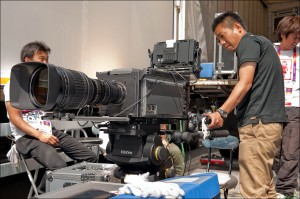Escapism…In 8K
 It’s almost time to pack away the batons and sweep up the many miles of streamers… I say almost, because now the Olympics have finished, it’s time for the Paralympics to shine – and if it’s anywhere near as good its predecessor, we’re onto a winner.
It’s almost time to pack away the batons and sweep up the many miles of streamers… I say almost, because now the Olympics have finished, it’s time for the Paralympics to shine – and if it’s anywhere near as good its predecessor, we’re onto a winner.
The coverage across all events was second to none and I, like many across the globe, found myself engrossed in sports I’d never bothered to watch before and even learnt some facts along the way (did you know that being given a score of “ippon” in Judo, results in immediate victory??).
So as someone who has become a self-proclaimed Olympics fanatic in the last few weeks, being given the opportunity to watch games coverage in Super Hi-Vision was too good to miss.
Over the years television has progressed from a black-and-white display, to colour TV and then to HDTV, which has become a household standard. Now companies are expanding their research into Super Hi-Vision, a television system with audio and video that provides a heightened sense of reality exceeding that of HDTV.
My opportunity to view this latest development came in the form of a demonstration of the highest definition TV format produced by Japanese Broadcaster, NHK. Super Hi-Vision (SHV) delivers a picture that is 16 times the resolution we see in today’s HD displays with a whopping 33 mega-pixels in a single frame and 120 frames per second. Only three of these cameras are in existence and all were present at the London Olympics to capture footage of the games. Screenings of this footage are being shown in Japan and USA as well as the UK, in cooperation with the BBC and the Olympics Broadcasting Services.
When fellow rAVe blogger and Women in AV Queen, Jennifer Willard sent me an article stating that the BBC would be hosting a viewing in London of SHV using coverage of the Olympics, I immediately sent a request for tickets.
At 2.45 p.m. on Saturday 11th August, the penultimate day of the Olympics, I am standing with the other visitors outside the BBC Broadcasting House near Oxford Circus, London and I am a little excited. After we are led through a brief exhibition of the history of broadcasting technology, including one of the first-ever televisions (which still works!), they usher us into the BBC Radio Theatre.
The footage is to be projected onto a 250” screen, which swamps the small room. Added to this is an impressive 22.2 surround sound setup which frames the screen to form an impressive view. Initially we are shown a replay of some of the opening ceremony which is a pleasure to see again, but it is the Veldorome’s cycling coverage that really shows off the camera’s abilities. A wide angle shot following the cyclists around the track shows the sharpness of the picture to its best, with the viewer able to pick out the tiniest details, such as members of the crowd’s faces and even the reflection of light off a TV camera lens at the opposite end of the Velodrome. This was enhanced further when a split screen presented an example of the Super Hi-Vision against a standard HD display showing the same crowd, this time heavily pixelated.
The engaging combination of a considerably large, hi-res picture coupled with surround sound that swiftly immerses you combines to create a supreme viewing experience. In fact, the experience was so engrossing that I felt nervous watching the 5,000 m run, even though I knew that GB runner Mo Farah would win.
Prior to the screening, I sat in Hyde Park enjoying some Olympics action on one of the several large outdoor LED screens that Panasonic supplied and installed throughout the UK. The HD footage was impressive, but more for its content; the contrast ratio and picture definition between HD and SHV is so vastly altered that there isn’t really a comparison between the two. 8K certainly delivers that sense of escapism that many of us seek when watching a film on the big screen.
As Jennifer pointed out in her post, NHK is estimating that this technology is years away from a commercial reality – the financial and technical challenges they face with current broadcasting and video capabilities (a raw 8K video feed requires 48Gbps plus another50mbps to cater for the 22.2 channels of sound, equalling 500Mbps for the total stream. By comparison, a standard 1080p HD TV is10Mbps, plus the likely issue of trying to fit an 85” screen (the smallest SHV display available) in your living room means we are still a way off yet.
NHK estimates that the first public trials of SHV will be around 2020, by which time they will need to have brought the required stream speed down to around 70Mphps. 4K may have the potential to hit the market earlier, but developments in technology are getting faster and now that we are seeing the capabilities of 8K broadcasting, perhaps Super High Vision it will arrive in homes sooner than we think?


